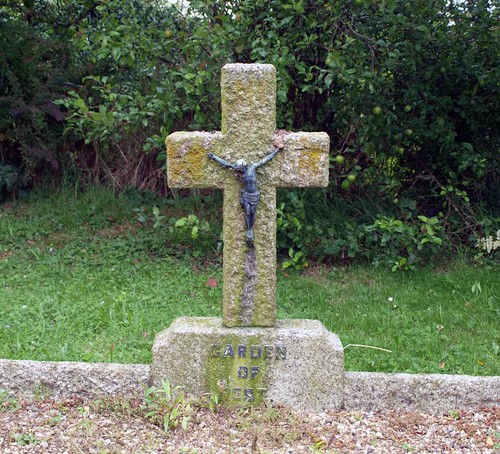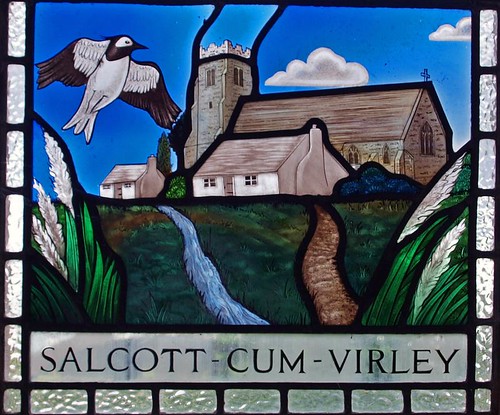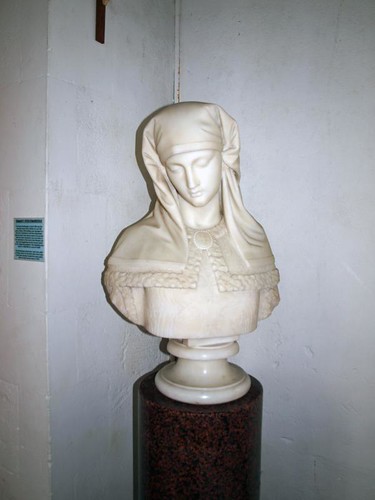ST MARY. W tower with some flint and stone decoration, much renewed - like the rest of the church - after the earthquake of 1884. - PULPIT. C18 with elegant stairs in inlay in the centre of the oak panels. - PLATE. Cup with band of ornament and Paten, both of 1574. Several good half-timbered houses in the village.
SALCOTT. An ideal place this remote corner of Essex must have been for the smugglers of silks and wines on winter nights, when the tide filled the creek in the marshland here. Old thatched barns and cottages line the quiet street, the post office most beautiful of all. Could any spot be better suited, we may wonder, for a game of hide and seek?
The church would be the nearest building to the creek a hundred years ago, and we may imagine from the holes in the doorway, into which the great beam fitted, that the door was often barred against smugglers and Preventive men. The church takes the place of one .which was shattered by an earthquake, but the splendid medieval arch of the tower withstood the shock, and the 16th century doorway still displays its ancient beauty. Propped against a buttress of the tower is a coffin lid 700 years old.
Two brothers of this place were associated with the dramatic quarrel of king and pope which changed the whole history of England. They were John and William Capon, distinguished sons of Cambridge and friends of Cardinal Wolsey. William was his chaplain, and was appointed dean of the famous college established at Ipswich by Wolsey from the funds he obtained from the suppression of religious houses. Ipswich College, however, did not survive its founder and William Capon retained his mastership of Jesus College, Cambridge, till four years before his death in 1550. John rose to higher rank, and as Abbot of St Benet in Norfolk we find him visiting Cambridge in 1529 to persuade his brother and other dignitaries to declare in favour of Henry’s divorce with Catherine of Aragon.
The reward for his success was his appointment as Abbot of Hyde, near Winchester, and we find John’s name among those who wrote to the pope begging him to consent to the divorce. A year later the king himself wrote to the pope asking him to allow the Archbishop of Canterbury and the Abbots of Westminster and Hyde to pass judgment on the divorce.
Two years later Henry nominated him to the bishopric of Bangor, but the pope refused to consent, whereupon the king assumed papal authority for the second time and told Archbishop Cranmer to consecrate him. A few years later, when the monasteries were being suppressed, John Capon willingly gave Hyde Abbey to his royal master, who made him Bishop of Salisbury, an office he managed to retain until his death in 1557. Foxe calls him a time-serving papist and a persecutor of martyrs under Henry and Mary; and we know that as an old man he sat in Southwark Cathedral and took part in the trial of that courageous and consistent saint, John Hooper.
Simon K -
We left Tollesbury on the coast and turned towards Colchester, with the prospect of a number of small churches in quick succession, not least because we were now entering earthquake country. The great Essex earthquake of April 1884 destroyed hundreds of buildings including wrecking a dozen churches, some of which were completely destroyed. There were two churches here, but only one was repaired, the former Virley parish church remaining as a picturesque ruin in someone's garden. Despite the name, this is just one tiny village divided by a stream, and they have not been separate parishes for a century or more, but the BoE still insists on giving them separate entries.
Open. This church was the real star of my day. It is gorgeous. Beyond the wire grill the inner doors were held open with heavy weights, and this is an utterly delightful High Anglo-catholic rustic church, reminding me of Calthorpe in Norfolk. It is lovely. Statues and candles, yes, but also simple woodwork and brick flooring. There is a poster advertising it as a Coffee Point, apparently a local initiative where anyone out for a walk or whatever can go into a building and make themselves a cup of coffee or tea and sit down for a rest. All the equipment for doing so was at the back of the church.
The entire church apart from the tower was destroyed in the earthquake, and was rebuilt some ten years later (fortunately late enough to escape the worst excesses of Victorianism). A mark of how High this church still is today is that the millennium window depicts the Roman Catholic symbol of the millennium. This was my favourite church of the day, and there were still several good ones to come.
The church would be the nearest building to the creek a hundred years ago, and we may imagine from the holes in the doorway, into which the great beam fitted, that the door was often barred against smugglers and Preventive men. The church takes the place of one .which was shattered by an earthquake, but the splendid medieval arch of the tower withstood the shock, and the 16th century doorway still displays its ancient beauty. Propped against a buttress of the tower is a coffin lid 700 years old.
Two brothers of this place were associated with the dramatic quarrel of king and pope which changed the whole history of England. They were John and William Capon, distinguished sons of Cambridge and friends of Cardinal Wolsey. William was his chaplain, and was appointed dean of the famous college established at Ipswich by Wolsey from the funds he obtained from the suppression of religious houses. Ipswich College, however, did not survive its founder and William Capon retained his mastership of Jesus College, Cambridge, till four years before his death in 1550. John rose to higher rank, and as Abbot of St Benet in Norfolk we find him visiting Cambridge in 1529 to persuade his brother and other dignitaries to declare in favour of Henry’s divorce with Catherine of Aragon.
The reward for his success was his appointment as Abbot of Hyde, near Winchester, and we find John’s name among those who wrote to the pope begging him to consent to the divorce. A year later the king himself wrote to the pope asking him to allow the Archbishop of Canterbury and the Abbots of Westminster and Hyde to pass judgment on the divorce.
Two years later Henry nominated him to the bishopric of Bangor, but the pope refused to consent, whereupon the king assumed papal authority for the second time and told Archbishop Cranmer to consecrate him. A few years later, when the monasteries were being suppressed, John Capon willingly gave Hyde Abbey to his royal master, who made him Bishop of Salisbury, an office he managed to retain until his death in 1557. Foxe calls him a time-serving papist and a persecutor of martyrs under Henry and Mary; and we know that as an old man he sat in Southwark Cathedral and took part in the trial of that courageous and consistent saint, John Hooper.
Simon K -
We left Tollesbury on the coast and turned towards Colchester, with the prospect of a number of small churches in quick succession, not least because we were now entering earthquake country. The great Essex earthquake of April 1884 destroyed hundreds of buildings including wrecking a dozen churches, some of which were completely destroyed. There were two churches here, but only one was repaired, the former Virley parish church remaining as a picturesque ruin in someone's garden. Despite the name, this is just one tiny village divided by a stream, and they have not been separate parishes for a century or more, but the BoE still insists on giving them separate entries.
Open. This church was the real star of my day. It is gorgeous. Beyond the wire grill the inner doors were held open with heavy weights, and this is an utterly delightful High Anglo-catholic rustic church, reminding me of Calthorpe in Norfolk. It is lovely. Statues and candles, yes, but also simple woodwork and brick flooring. There is a poster advertising it as a Coffee Point, apparently a local initiative where anyone out for a walk or whatever can go into a building and make themselves a cup of coffee or tea and sit down for a rest. All the equipment for doing so was at the back of the church.
The entire church apart from the tower was destroyed in the earthquake, and was rebuilt some ten years later (fortunately late enough to escape the worst excesses of Victorianism). A mark of how High this church still is today is that the millennium window depicts the Roman Catholic symbol of the millennium. This was my favourite church of the day, and there were still several good ones to come.



No comments:
Post a Comment